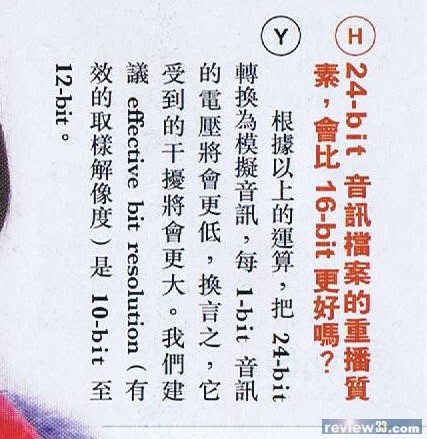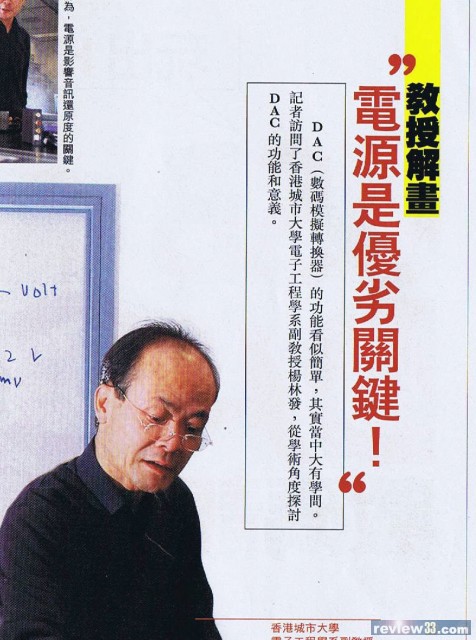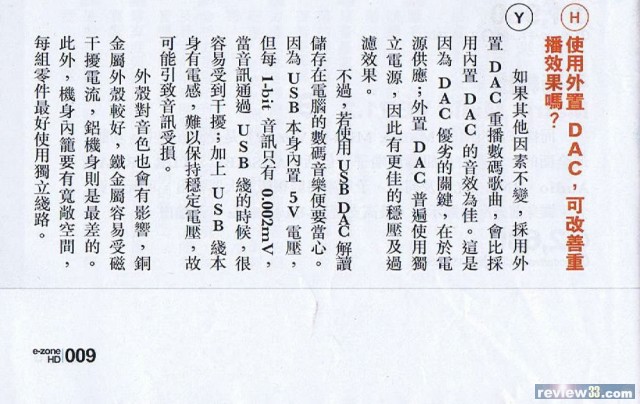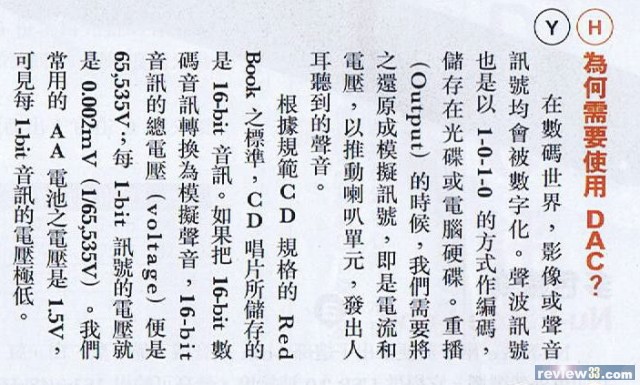兩聲道
CD機 | MD機 | SACD機 | DAC | CAS | 合拼擴音機 | 前級擴音機 | 後級擴音機 | 接線 | 喇叭線 | 揚聲器 | 耳機 | 耳機擴音機 | LP產品 | 膽機產品 | 開卷式錄音機 | 音響配件 | DIY音響 | 電源 | 家庭影院
電視機 | 投影機 | 錄影機 | DVD影碟機 | Blu-ray影碟機 | 多媒體播放器 | 機頂盒 | 多聲道擴音機 | 多聲道揚聲器 | 多聲道影音組合 | Mini音響組合 | 重低音揚聲器 | 輔助設備 | 同好會
同好會 | Accuphase | B&W | Burmester | Denon | Jadis | KEF | KRELL | Luxman | Marantz | Nuforce | OPPO | Pioneer | TEAC | WEISS | News
News | Blog | 其他
其他 | 所有 |
| 影音天地主旨 ﹝請按主旨作出回應﹞ 下頁 尾頁 | 寄件者 | 傳送日期
|
| [#1] 24bit 唔及12bit? 電子教授話24bit音訊解碼唔好,最好係10至12Bit,my god!唔係甘玩呀嘛,我地R33 D CAS 專家點睇  |
raymond20 58.xxx.xxx.96 |
2010-05-02 18:14 | |
|
|
|||
| [#2] 24bit 唔及12bit? 專家芳容  |
raymond20 58.xxx.xxx.96 |
2010-05-02 18:16 |
| [#3] 24bit 唔及12bit? 主要內容 from Ezone  |
raymond20 58.xxx.xxx.96 |
2010-05-02 18:18 |
| [#4] 24bit 唔及12bit? thanks all the message and very important can you post all the pages? or send me the link |
batmanames04 114.xxx.xxx.167 |
2010-05-02 18:41 |
| [#5] 24bit 唔及12bit? 我無意中在家中舊雜誌睇到,我scan咗來存檔,我唔知post曬上來有冇問題,共有五頁,有訪問馮禮慈及DIY007.net 的Lau Sir 對 USB DAC 的意見,你 pm 我留 Email 我存比你 |
raymond20 58.xxx.xxx.96 |
2010-05-02 18:50 |
| [#6] 24bit 唔及12bit? Some theory ok. But a few theories are not what we experienced..... |
musimusi 219.xxx.xxx.93 |
2010-05-02 22:08 |
| [#7] 24bit 唔及12bit? 見有 E-Zone Logo 就唔洗理 |
wosoloo 119.xxx.xxx.114 |
2010-05-02 22:12 |
| [#8] 24bit 唔及12bit? Wavelength Audio 上年出過部 好似得16bit/48kh的Dac,重得外國大音響書A+榜,甘D 24bit ,36bit ...無限bit系搞緊乜,系音效定音響? |
raymond20 58.xxx.xxx.96 |
2010-05-02 22:38 |
| [#9] 24bit 唔及12bit? 好簡單,自己將個24/96 file downsimpling 16/96或 16/48 比較即知。 |
blackmagichunter 119.xxx.xxx.246 |
2010-05-02 22:41 |
| [#10] 24bit 唔及12bit? 耳仔收貨 |
we247 219.xxx.xxx.211 |
2010-05-02 22:46 |
| [#11] 24bit 唔及12bit? 其實睇你要音效定音樂,好似影相甘,D中古Leica鏡先有味道,D 新 NIKON 鏡就得個sharp字,藝述既野無準則的,音響到了一個境界,已經唔係計高中低音,係講令人感動的音樂味,呢D就係我而家唔明白的野. |
raymond20 58.xxx.xxx.96 |
2010-05-02 22:55 |
| [#12] 24bit 唔及12bit? 1 bit of usb link is 0.002mv? does he know that it is a digital signal transferred over the usb link? someone must be on drug^-^ |
Not-So-GoodSamaritan 121.xxx.xxx.246 |
2010-05-02 23:20 |
| [#13] 24bit 唔及12bit? 教授甘講,我都好難相信,D CAS 友一定睇到眼突突,好似以前的努力研究,都係幻覺. |
raymond20 58.xxx.xxx.96 |
2010-05-02 23:26 |
| [#14] 24bit 唔及12bit? see  |
raymond20 58.xxx.xxx.96 |
2010-05-02 23:32 |
| [#15] 24bit 唔及12bit? 教授甘講,我都好難相信 --------- 教授 means next to nothing. if he bullshits, he bullshits. |
Not-So-GoodSamaritan 121.xxx.xxx.246 |
2010-05-02 23:33 |
| [#16] 24bit 唔及12bit? i think you got confused or he did. the beauty of being digital is that the original signal level is no longer relevant. if one questions the integrity of the usb digital transfer, it is not because it is transferring 24bit data. |
Not-So-GoodSamaritan 121.xxx.xxx.246 |
2010-05-02 23:41 |
| [#17] 24bit 唔及12bit? let's listen to Dan Lavry, the creator of Lavry DA11 DAC, talk about the Bit theory and others: >>>>>>>>>>>>>>>>>>>>>>>>>>>>>>>>> Why 6dB per bit: In digital audio, you "take samples" of the sound, and then place a value on each sample. You can think of it as placing a transparent grid on a drawing on "going for the closest" point of the grid. The vertical lines of the grid are for sample time, and the horizontal lines are for sample value (sample amplitude). We will focus on the horizontal lines. In the real world, each sample is assigned the value of the closest horizontal line just below it. Think of money. Say one buys an item for one $1.05, but the tax is 3%. That gives you a total of $111.1419048.... As you can see, we go for the closest penny and settle for $111.14 Similarly, we have to settle for some precision in the digital word, and only accommodate "good enough" number of bits". We can just "keep going forever", nor do we need to. So say you have only 2 bits. That means the horizontal grid is made of only 4 lines. Now add a bit. You now have 3 bits. Adding that bit means adding a new horizontal line right smack at the middle, between the each "existing" lines of the 2 bit system. (With 3 bits you have 8 levels). Now, add another bit, with 4 bits you have 16 levels. In fact, you take the 3 bits grid, and add a new line between each pair of "existing lines". So each additional bit DOUBLES the number of quantization levels (horizontal lines). In fact, the space between the lines (quantization error) is halved for each added bit. With a voltage linear system, twice the voltage, would mean twice the loudness. With a power linear system, twice the power, would mean twice the loudness. But the ear is not at all linear. Now we want to go with that above information and apply it to the ear. The ear reacts to loudness with a scale that is nearly logarithmic. So what is a factor of 2 mean? The dB scale for voltage is dB=20*log(X) so we plug in X=2 and get dB=6.02 In the "logarithmic world", multiplication is turned into addition, division becomes subtraction. So double the number of lines means adding 6dB. Half the error means 6dB more dynamic range. Half the error again means 6+6=12dB... and so on This all may sound strange. Why is ear logarithmic? For that you have to address mother nature. One way to "reason it" is protection of our hearing. As things get louder, the ear response becomes lesser and lesser... That way we are protected from some huge acoustic power damaging our hearing. If one is not into the math and engineering, think of loudness being perceived accordion to a "curve" that translates voltage (or power) into loudness in some way that can be figured mathematically or graphically, and it is not a "straight" conversion. So how many quantization lines do we need? That does depend on the ear, but with 20 bits, that is plenty good, we can not hear better then 20 bits in the most extreme cases!!! Note that while each additional bit (new horizontal line), you get closer to the sample values, at some point, with enough grid lines, the spacing is so close that there is not much to be gained from more quantization lines. At 20 bits, you have a round 1 million lines! That is 6dB X 20 = 120dB. So why 24 bits? Well in the computer world, much is being handled in "multiples of 8 bits", which is a byte. As long as we had a 16 bit format, it was 2 bytes. The minute you went for 17 bits, the hardware and software required one more byte, and 2 X 8bits = 24 bits. The last bits are just there, they do not help the music, because the signal never gets to be 24 bit accurate. We can not do it, because of analog noise, and we do not need it because the ear does not hear 144dB. Regards Dan Lavry Lavry Engineering >>>>>>>>>>>>>>>>>>>>>>>>>>>>>>>>>>> You can hear better then 16 bits, 18 "real bits" is better then 16 bits, I would not mind 20 bits. And a little faster sample rate then 44.1KHz is better also. 48KHz is better then 44.1KHz. 88.2/96KHz is also pretty good. Any faster is not a good idea. I heard some real beautiful 96KHz 24 bits (probably 18-20 real bits). Some of the high definition audio (DVD Audio) is fantastic to listen to. It is unfortunate that it did not gain commercial acceptance. At the end of the day, I too do most of my listening to CD format (16 bit at 44.1KHz). I would like to have a few more bits, and somewhat faster sample rate. I would love to have say 18-20 real bits (that means 24 bits format) at 60-70KHz. But given that most of the music comes on CD's, I listen to CD's... And there are some fantastic CD's out there. Regards Dan Lavry >>>>>>>>>>>>>>>>>>>>>>>>>>>>>>>>> First: Jitter is important for digital audio but atomic clock is not less jitter! Atomic clock offers time accuracy such as nanosecond drift over a long time. This is important in many applications but useless for audio. Even a poor crystal, say 500 parts per million will alter the pitch of the music by less then 1 cent (which no human can hear). Also, a 100ppm crystal (pretty poor) will make hour music longer or shorter by 0.36 second, and no one would care. Jitter is important, and atomic clocks do not offer particularly good jitter. They cost a lot but that does nit change the facts. Second 32 bits? We use a lot of bits for audio work station. We need that for mixing and editing of audio tracks. But the outcome is 24 bits or less. In fact, the individual audio channels recorded by an AD NEVER have 24 bit accuracy. 20 bits is real good! The other bits may be there but they are just random noise, not at all connected to the music. Those lower bits are the noise floor. We are restricted to such noise levels because of analog noise in components but with careful design, we keep that noise low, as low as say 21 bits. This is not bad! Why? Because the EAR can only hear a certain dynamic range (from the loudest to the lowest levels. Each bit is around 6dB so at 20 bits we have 120dB dynamic range. That is huge. A CD has only 16 bits thus 96dB and that is already pretty quiet. If you stand next to a 747 engine (running), and call it the loudest you want to hear, then go to a sound isolation room and call it the lowest sound level, you have less then 126dB which is 21 bits. So who needs 32 bits? When it comes to digital audio workstation, you need that and more. For listening, no one needs even 24 bits. Third 384KHz, as well as 192KHz is marketing driven, and it is NOT GOOD for best sound. Too slow is not good, and too fast is not good either. There is an optimal sample rate, and it is somewhere in the 60-70KHz. Of course there is no such standard so 48 or 88.2KHz is reasonable, and even 96KHz is just a bit too fast. I explained all that in great detail in my paper "Sampling Theory". The paper is too technical for some folks, I tried to keep is comprehensible... Regards Dan Lavry Lavry Engineering >>>>>>>>>>>>>>>>>>>>>>>>>>>>>>>>>>>>>> Originally Posted by Dan Lavry 192KHz is the wrong thing for audio! It is not a usb issue, it is a conversion issue. While too slow a rate is a bad thing, so is too fast. If the rate is too slow, one losses the high audible frequencies. If the rate is too fast, one looses conversion accuracy, not to mention very large files for no good reason. The marketing of 192KHz has been about "more is better", and to support it, they pointed out that 48KHz can sound better then 44.1KHz. That DOES NOT automatically imply that 1GHZ (1000000000 Hz) would sound fantastic. In fact, at 1GHz, you will be lucky to have 4 bits of audio - that is worse then the early Edison phone experiments. So if too slow is not good, and too fast is not good, it leaves somewhere in between - an optimal rate. The pushers of 192KHz try to tell you that more is better, like pixels for audio, money in your pocket and so on. But the analogy is WRONG. Audio signal is NOT like video pixels. I did write a long paper about it - "Sampling Theory", and it is on my web site. I also decided NOT TO SUPPORT 192KHz, and that is not a usb issue. At this point in time, the marketing driven 192KHz has lost most of the steam, but some are still caught in the false notion that it offers something better. In fact, 88.2-96KHz is much closer to the optimum rate. Regards Dan Lavry |
quarch 219.xxx.xxx.66 |
2010-05-03 00:19 |
| [#18] 24bit 唔及12bit? I think USB Bullshit written by Mag writer, not the professor, as I also interviewed by mag few times, those writers can't fully express my idea but insert their own on my words.... |
hercules 112.xxx.xxx.234 |
2010-05-03 00:53 |
| [#19] 24bit 唔及12bit? Low Noise Floor and High S/N ratio is important, power noise have direct impact on it. But the digital signal mostly in High or Low State, not at mv level voltage until output from the DAC chip. |
hercules 112.xxx.xxx.234 |
2010-05-03 00:59 |
| [#20] 24bit 唔及12bit? Hercules兄, Good point ,你好可能說中其中要害,不過Quarch 的資料好有用,令我明白左好多不解之迷,唔洗成日道聽途說.Cheers! Goodnight |
raymond20 58.xxx.xxx.96 |
2010-05-03 01:01 |